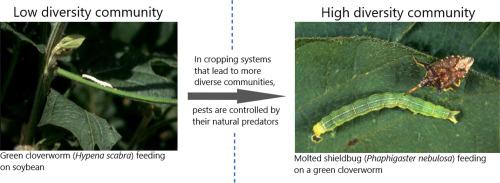当前位置:
X-MOL 学术
›
Biol. Control
›
论文详情
Our official English website, www.x-mol.net, welcomes your
feedback! (Note: you will need to create a separate account there.)
Friends or Foes? Population dynamics of beneficial and detrimental aerial arthropods under Conservation Agriculture
Biological Control ( IF 3.7 ) Pub Date : 2020-09-01 , DOI: 10.1016/j.biocontrol.2020.104312 Blessing Mhlanga , Tarirai Muoni , Nilton Mashavakure , Derek Mudadirwa , Rabson Mulenga , Mwangala Sitali , Christian Thierfelder
Biological Control ( IF 3.7 ) Pub Date : 2020-09-01 , DOI: 10.1016/j.biocontrol.2020.104312 Blessing Mhlanga , Tarirai Muoni , Nilton Mashavakure , Derek Mudadirwa , Rabson Mulenga , Mwangala Sitali , Christian Thierfelder

|
Abstract Arthropod pest control is one of the most critical agronomic practices in cereal-based cropping systems. Cropping systems that preserve or promote biological pest control agents are more desirable. Data collected from a long-term trial at the Monze Farmer Training Centre (MFTC) from 2009 to 2012 was used to compare effects of different Conservation Agriculture (CA) systems with conventional practices (CP) on arthropod species diversity and populations with specific emphasis on beneficial and detrimental aerial arthropods. Up to 13 arthropod orders comprising of 40 species were identified in the cropping systems and their population density differed in years and cropping systems. Higher diversity was observed in CA systems in all years based on the Shannon-Weiner indices ranging from 0.4 to 2. However, a CP system with no rotations (CP-M) showed comparable results in the year with low rainfall. Community evenness increased in the same year with a value of 0.46. More beneficial and detrimental arthropods were recorded in a CA system with a three-year rotation of maize, cotton and sunnhemp reaching up to 9533 individuals ha−1. The CP-M recorded the highest increase in detrimental arthropods from 2009 to 2012. A canonical correspondence analysis did not show a clear-cut association of both CA and CP systems with either beneficial or detrimental arthropods. However, associations were more driven by seasonal effects. Reduced soil disturbance, crop residue retention and crop diversity in CA systems preferentially attracted beneficial arthropods while preserving existing favourable arthropods. Conventional tillage systems often disturbed arthropod habitats, disrupted their life cycles leading to lower biological activity. Increased biodiversity from CA systems may therefore support biological control.
中文翻译:

朋友还是敌人?保护性农业下有益和有害空中节肢动物的种群动态
摘要 节肢动物害虫防治是谷类种植系统中最重要的农艺措施之一。保存或促进生物害虫防治剂的种植系统更为理想。从 2009 年至 2012 年在 Monze 农民培训中心 (MFTC) 的长期试验中收集的数据用于比较不同保护性农业 (CA) 系统与传统做法 (CP) 对节肢动物物种多样性和种群的影响,特别强调有益和有害的空中节肢动物。在种植系统中发现了多达 13 个节肢动物目,包括 40 个物种,它们的种群密度因年份和种植系统而异。基于范围从 0.4 到 2 的香农-韦纳指数,在所有年份的 CA 系统中都观察到了更高的多样性。然而,无轮换的 CP 系统 (CP-M) 在降雨量较低的年份显示出类似的结果。同年,社区均匀度增加了 0.46。在 CA 系统中记录了更多有益和有害的节肢动物,玉米、棉花和洋麻的三年轮作达到了 9533 个体 ha-1。CP-M 记录了从 2009 年到 2012 年有害节肢动物的最高增长。规范对应分析没有显示 CA 和 CP 系统与有益或有害节肢动物的明确关联。然而,关联更多地受到季节性影响。CA 系统中减少的土壤干扰、作物残留物保留和作物多样性优先吸引有益的节肢动物,同时保留现有的有利节肢动物。传统的耕作系统经常扰乱节肢动物的栖息地,扰乱它们的生命周期,导致生物活性降低。因此,来自 CA 系统的生物多样性增加可能支持生物控制。
更新日期:2020-09-01
中文翻译:

朋友还是敌人?保护性农业下有益和有害空中节肢动物的种群动态
摘要 节肢动物害虫防治是谷类种植系统中最重要的农艺措施之一。保存或促进生物害虫防治剂的种植系统更为理想。从 2009 年至 2012 年在 Monze 农民培训中心 (MFTC) 的长期试验中收集的数据用于比较不同保护性农业 (CA) 系统与传统做法 (CP) 对节肢动物物种多样性和种群的影响,特别强调有益和有害的空中节肢动物。在种植系统中发现了多达 13 个节肢动物目,包括 40 个物种,它们的种群密度因年份和种植系统而异。基于范围从 0.4 到 2 的香农-韦纳指数,在所有年份的 CA 系统中都观察到了更高的多样性。然而,无轮换的 CP 系统 (CP-M) 在降雨量较低的年份显示出类似的结果。同年,社区均匀度增加了 0.46。在 CA 系统中记录了更多有益和有害的节肢动物,玉米、棉花和洋麻的三年轮作达到了 9533 个体 ha-1。CP-M 记录了从 2009 年到 2012 年有害节肢动物的最高增长。规范对应分析没有显示 CA 和 CP 系统与有益或有害节肢动物的明确关联。然而,关联更多地受到季节性影响。CA 系统中减少的土壤干扰、作物残留物保留和作物多样性优先吸引有益的节肢动物,同时保留现有的有利节肢动物。传统的耕作系统经常扰乱节肢动物的栖息地,扰乱它们的生命周期,导致生物活性降低。因此,来自 CA 系统的生物多样性增加可能支持生物控制。











































 京公网安备 11010802027423号
京公网安备 11010802027423号